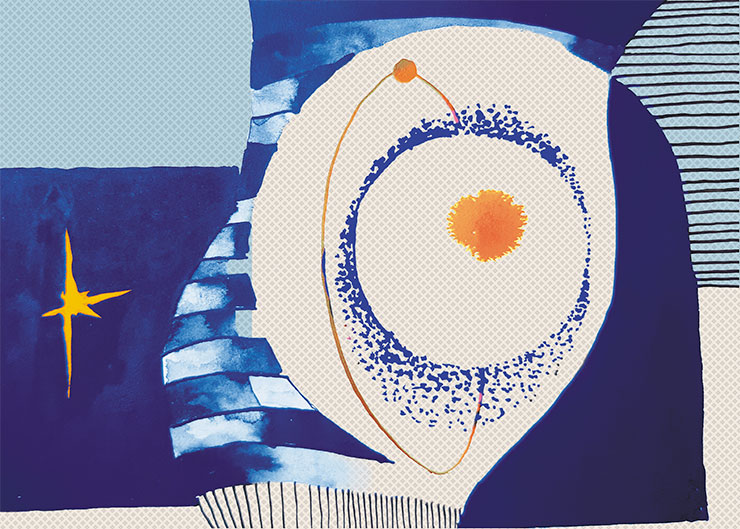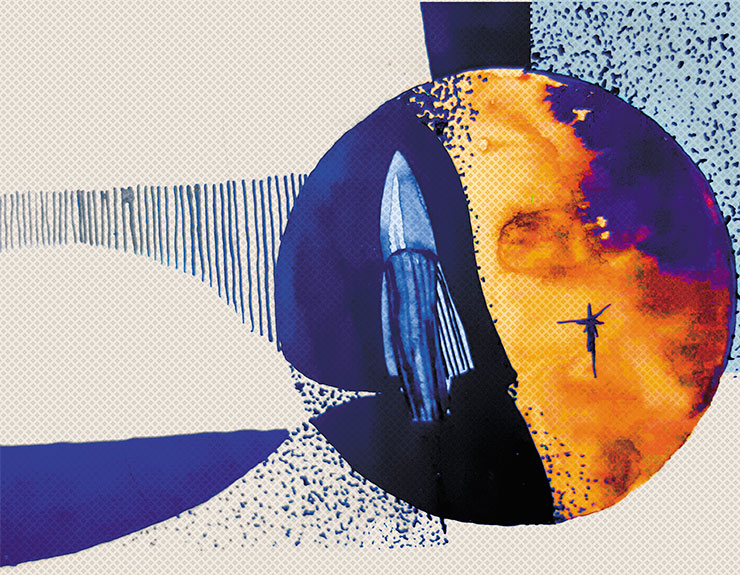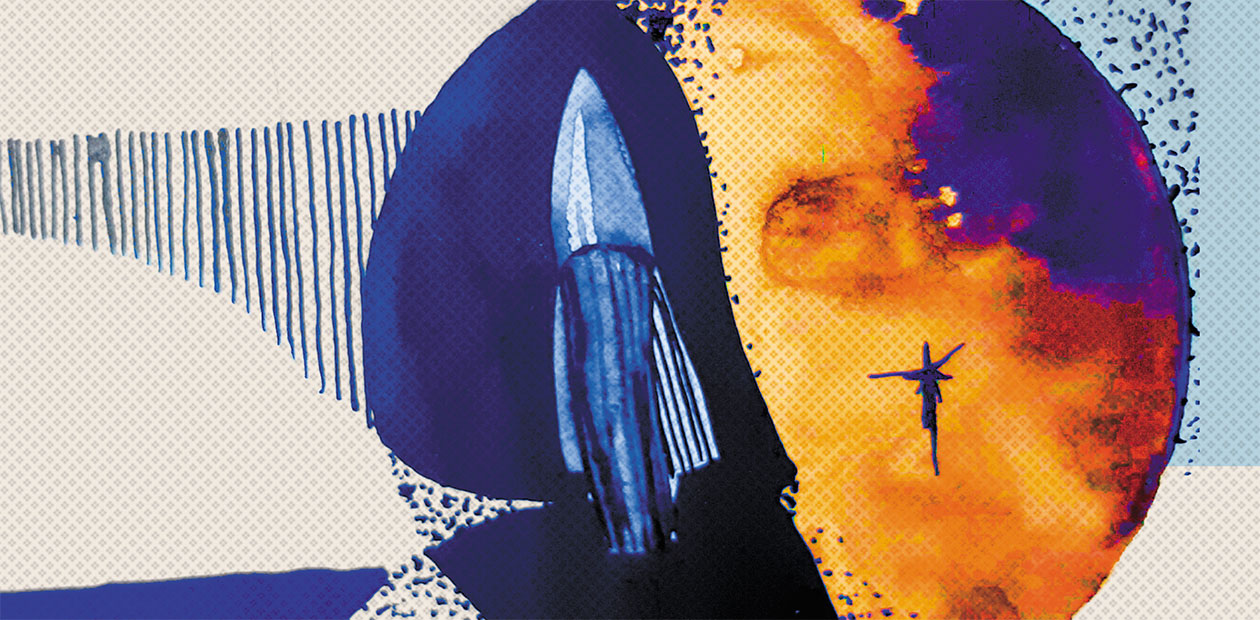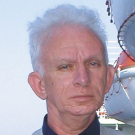Metronome
This science-fiction short story by Pavel Amnuel about a pulsar-orbiting planet illustrates the idea about the possibility of predicting discoveries, which is discussed in his article “Future of Science: Discoveries – Expected and Unexpectable”
The doctors told the truth: Kim Yavorsky indeed changed after the accident, as if all his life force had gone into restoring his hand.
Basiola hoped to sneak in without a sound, but a branch cracked under his foot. Caught off-guard, he stumbled over a hose that lay across the path and, barely keeping himself from falling, grabbed a rose bush. Kim, who turned back at his scream, watched his friend’s manipulations with a smile. They hugged.
“You’ve lost weight, Kim,” Basiola said, almost approvingly.
“Lost weight?” Yavorsky doubted him. “Ah, yes, we haven’t seen each other long. I lost twelve kilos when I was prepping for the zero-trans test, and another five after the accident. And don’t you look at me like that, Joo…”
“We don’t see each other much,” Basiola sighed. “At the institute I knew you in-and-out, but now only your outer shell looks familiar… almost.”
“You’d better drop me a problem, an unsolved one,” said Kim. “I got moldy in this clinic. Look, caterpillars are crawling all over me… Before the accident I was working on a discovery heurister. Have you heard of it?”
Basiola had. Basiola’s attitude towards Kim’s work was certain and, of course, negative. Basiola did not want to discuss it now; he had no desire to turn this meeting with his old friend, whom he had not seen for three years, into a fruitless methodological dispute.
“I saw your Olya,” he said, clumsily changing the subject. “She’s growing more beautiful…”
“And me, not so much,” Kim finished his phrase. “Listen, Joo, if any of us two has changed, it’s you. You always pushed me away if you thought crazy that another idea of mine. Now you don’t believe in the predictability of scientific discovery, and you dodge the dispute. It doesn’t sound like you… Drop me a problem. You must have more problems than solutions at your Contacts Committee, don’t you? Remember the story with the Dorado pulsar.”
“That thing isn’t worth all that talking,” Basiola said vaguely.
“What is it worth then?”
“A memorial stone,” muttered Basiola. “They found a dead civilization. The pulsar is only half a parsec away, but it does not radiate in the Earth’s direction, so it’s impossible to detect it from here. The Formalhaut mission only by chance recorded its pulses in the radio and gamma ranges. That same mission discovered the planet…”
“I know why you don’t mention the ship,” Kim interrupted him, looking away. “It was Kratov, on Octopus. He didn’t return, and it’s prejudice that’s now talking in you…”
“Yes, Kratov. And they named the pulsar the Kratov Star, and they called the planet Kratov I. A Vint-type automatic probe made a flyby. And it discovered a dead world.”
“Dead?”
“Absolutely. Nothing alive can possibly exist when the pulsar showers the planet with gamma rays. And it does so every three seconds. Every three seconds, Kratov-I lies under the knife of radiation. The impulse lasts for a fraction of a second, but even during that time the planet gets such a dose that life becomes impossible. They sent the Vint during a silent period. Like any pulsar, the Kratov Star rages for about half a year and then lies dormant for a year and a half, accumulating energy in the surface layer. The Vint circled the planet and flew up to the neutron star, as close as it could get with its power resources and dynamic tensile strength. We, the contactees, didn’t put any of our instruments onboard since no one expected to discover any traces of life. Keep in mind that a supernova exploded in that system a few million years ago. That’s when the pulsar emerged. If there had been life on that planet, it would’ve died, of course, during the explosion, and only then… the Black World appeared with a deadly burst of radio and gamma rays every three seconds. Have you got a stereoscope with you?”
Kim pulled a box from his side pocket, and Basiola began to hand him holograms, one at a time.
The frames covered large areas, and despite the resolution of the images being perfect (as it usually is on atmosphereless planets), enabling one to see objects the size of a dog, the eye could not focus on a multitude of objects as attention was jumping unconsciously from one thing to another. Structures resembling regular polyhedrons; chains of hemisphere-shaped holes stretching for dozens of kilometers; perfectly flat sites, the purpose of which (Kim thought at first they could have been spaceports) could be anything. At the bottom of one of the holes, Kim saw something that looked like an excavator with a raised dipper, and this could also be anything, even the planet’s inhabitants themselves, frozen forever at the moment of their unexpected death. No mountains, no steeps, no abysses – if these living features had ever existed on the planet, they had been sacrificed to the civilization, which in turn fell victim to the star explosion.
Yavorsky changed the holoframe, but the picture was almost the same. The third frame, too, was the same, and the fourth one…
“The Vint made half a million scans,” Basiola clued him in. “The planet’s surface was covered six times. The ones I’m showing you, Kim, are selected shots, the most spectacular ones. If there had been anything moving on the surface, they would’ve isolated the signal. But there’s nothing. Everything’s dead.”
“So what do you want from me?”
Basiola could hardly contain his laughter. What a character! And this man asked for a problem a minute ago.
“I want nothing. This is a planet for archaeologists, not contactees.”
“No movement,” Kim drawled, “is that really so? Movement, if it’s very slow, may go undetected. It’s like shooting a turtle in rapid motion.”

“Two and a half million years have passed since the supernova explosion,” Basiola set out to explain it all with enjoyment. Kim was now repeating his own line of reasoning, and Basiola felt like a traveler who had set foot on solid ground and was helping a friend to overcome a swampy place. “This is too short a time period for life to develop. If life indeed had emerged on the Kratov planet and had developed so quickly into a technological civilization, then we cannot talk of a slow pace of evolution. You can’t build a house in a month if you lay one brick a week. This idea didn’t work out.”
“And which one did?” Kim asked meekly.
“None did,” muttered Basiola, “it was decided to send another Vint during the next silence of the pulsar.”
“A nice strategy, strictly by the book. The chapter ‘How Not to Do Research’.”
“All the other strategies are vapid.”
“I have to go,” said Kim, rising up from the bench. “I’m having my treatments now. Bye, Joo. Ring me up and call in. Ah yes… What’s the point of flying there in a period of silence?”
“Hey, listen,” Basiola uttered in amazement to Kim in his wake. But his friend was striding away and did not look back.
***
Sandra was at home, and a cake was on the table, his favorite one, with apples. Basiola kissed his wife and went straight into his study.
The methodology of discovery. Basiola did not follow Kim’s latest forays into this hopeless domain. Not being a retrograde, he admitted that Yavorsky could still be right about something. Learning how to predict – what kind of discovery and in what field of science will be made tomorrow or in a year from now. Basiola did not like it. Where is the romance? Where is the very meaning of search in science? Won’t we lose it all? Philosophers had better answer these questions.
Okay, let’s leave philosophy for now. “What’s the point of flying?” Kim said. Of course, Basiola could call him and ask. Backed into a corner, Kim would say everything he had to say about the Kratov planet. But that would mean that Basiola had capitulated.
Okay, let’s go down the chain. There is no life, but there it is. Yavorsky’s unfinished methodology, as far as Basiola knew it, possessed dozens of tricks with which Kim got rid of scientific controversy. Going through the tricks without knowing which one to use at the moment is like solving a math problem by the old-fashioned trial-and-error method. Kim did not work like this; he must have known when to use each of his tricks. He solved the problem right in front of Basiola, in plain sight, and did not tell him the solution. Rascal, he wanted Basiola to come to him again. He wanted him to throw out the white flag. And he knows that it will be so. Basiola will not send a second probe to the Kratov Star if there is even half the thought that the flight is unnecessary.
Sandra came in and sat down quietly on the arm of the chair. Basiola woke up from his thoughts.
“Sandra, darling,” he said, “six years ago I made a brilliant discovery, and for some reason it’s not taught in schools. I discovered you. It was unexpected and unpredicted. And it’s so good that I’m still amazed. But your good friend Kim Yavorsky claims that any discovery can be predicted. Was it possible to predict what you and I have discovered in each other?”
“Is that what you care about?” Sandra asked earnestly.
Basiola nodded ‘yes’.
“Perhaps, it was possible,” said Sandra, giving it some thought. “Each person has certain expectations from a life partner, and if these expectations correlate… Attitudinal homogeneity, as psychologists say… It well may be possible to calculate, right?”
“Think what you’re saying!” Basiola flung up his hands. “You, a woman, an unpredictable human being!”
“A contradictory human being,” Sandra smiled. “Why unpredictable?”
“I’m sorry, dear,” murmured Basiola, “I need to think…”
What if I say, breaking through all the barriers: there is life on the Kratov planet. We see it, but we do not believe what we see. We can’t send a probe, but time is running out – the pulsar will go into another cycle, and we’ll have to wait again.
Why not? What do you mean by “why not”? These are obvious things; these are axioms; the thinking inertia has nothing to do with it. During the active periods, the star emits the deadly gamma rays…
A stereotype, Basiola thought. Let’s break down this axiom. Let’s assume that life exists only when there is this radiation knife that cuts everything. But… No, no, think it through, maybe it’s just a blank shot, but think it through anyway. Once we flip the main axiom, we get…
***
“How’s your hand?” asked Basiola.
Kim hit the bench with the edge of his hand, not very hard it seemed, but the board broke apart.
“You’ll have to fix it,” Basiola said maliciously.
“I’ll fix it when I’m back from the mission.”
“Are you going to fly?” Basiola was surprised. “Where?”
“To the Kratov Star. Isn’t it what you were going to propose?”
“Your discernment gets on my nerves sometimes,” Basiola muttered.
“Okay, Joo,” Kim said placatingly, “I got sick of idleness. It’s not good for my moods. Have patience, please. I’ll be a different man when I’m back. Are you here for a solution?”
“I don’t need your solution, I have mine. The Committee decided to send a mission during the pulsar’s active period. And you’ve been asked to lead the crew. True, there are no humans on it, only robots…”
“I’m used to being alone,” said Kim. “So, you’ve figured out the solution, haven’t you?”
***
The pulsar was impossible to look at. The dull alternation of the flares, endless and rhythmically precise, was depressing. Kim felt as if he was losing his mind – the star was opening its bewildering embrace, and he was falling and falling into it… Only once did he try to look the star in the “face” and never did it again.
The ship was flying away from the side of the pole, but he could hear the echoes of stellar storms here too. Kim was pleased. Not by the fact that his idea was true, of that he had had no doubt. Kim was thinking about how right he was in choosing this profession. As early as in his first year of study, he faced a dilemma: to fly or to predict. To touch rough stones on alien planets with his own hands or to sit in a chair and look into the blue depths of the Earth’s sky, predicting what will happen in science tomorrow or years later. He knew how and loved to do both! Only now, having fastened his seat belts and no longer looking back at the Kratov Star, Kim realized that this contradiction of desires was probably that perpetual accelerator that would not let him quiet down, always pushing him to do weird things.
The man ought to have several professions at once. Basiola, his old friend, has walked too straight a path in life: a contactee cybernetician, a member of the Committee, a chairman. A straight path is precisely where inertia arises. It seems as if it’s not there, but then the speed is too high, and it’s no longer possible to make a turn without help, without an outside push.
The pulsar was raging, and Kim was filming it from a distance of sixteen million kilometers, where he could work without risking his precious life. One of the cameras was filming Kratov-I at those moments when the knife of gamma pulse did not touch the surface. Filming, not scanning, like the Vint did. In the guidance mode, focusing on one point Kim chose at random, near the pole. The first series of frames showed no movement. The second one showed no movement. And the third. But in the first series, the motionless mechanism (or creature?), resembling an excavator, pointed its dipper up. In the second series, a little sideways. In the third one…

Here is the second cycle of holograms, from another camera, captured in those seconds when the radiation knife was shredding the planet. In those seconds when the gamma-ray flares were burning and killing it. And here it is – movement! The dipper tilts slowly. Another mechanism crawls out from the funnel… or is it a living being?
Life – in chunks. There it is, and there it isn’t. The pulsar flares up, and the planet lives. The darkness lasts a few seconds, and in those seconds – life stops.
We, humans, are so used to our quiet Sun, to its homogeneous energetics. We tend to forget in our everyday life that nonstationary processes are much more common throughout the Universe. They are its common feature. And we deny them the possibility of giving birth to life.
Darkness, and a flare. Darkness, and a flare. A metronome. A rhythm nothing could disturb, this rhythm set a foundation for this strange life. In those moments when the pulse hit the Kratov-I planet, life was developing. In the seconds of darkness, all life froze on it, as if a power system was switched off. Death, too, reigned on the planet in those months when the pulsar did not radiate, when it was accumulating energy.
Kim imagined himself a host of that planet. I can see, and I cognize the world. For me, the time when the pulsar is silent does not exist. I do not live during this time. An object starts to fall – I see it, but then it disappears and immediately reappears on the surface. Well, then so be it, such is the law of nature. It would never occur to me that I just do not record a part of that fall as I do not live in those moments. This is my rhythm. The rhythm of my star.
The starship’s behavior must also seem strange to them. It is moving in jumps – first it moves slowly against the background of the stars, but then it suddenly disappears and reappears a little to the side, and then again moves slowly, and again makes a jump. But what’s so strange about that? All stars move the same way. There is nothing in the Universe but pulses. Such is nature. And so are its laws. Everything that has been so since time immemorial cannot be strange…
***
Kim was waiting for Basiola to get in touch first. Of course, he was anxious to know. Well, Joo, are you convinced now that discoveries can be predicted?
The illustrations from Pavel Amnuel’s personal archive.
Published in the Tekhnika i nauka (‘Engineering and Science’) magazine, No. 6, 1982










